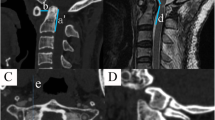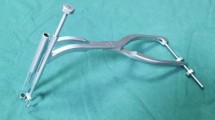Abstract
Background
Irreducible atlantoaxial dislocation (IAAD) is a disorder of atlantoaxial joint instability with various causes. The diagnostic criteria for IAAD are variable. The diagnosis of IAAD is mainly based on preoperative and intraoperative traction results, as well as the physician’s experience, with no relatively uniform guidelines for the selection of treatment. This study evaluates sagittal atlantoaxial joint inclination (SAAJI) and reduction index (RI) values for diagnosis and treatment of IAAD.
Materials and Methods
24 IAAD patients treated in our hospital from January 2008 to July 2014 were retrospectively analysed. Patients included were 13 males and 11 females, with a mean age of 43 years. The various causes for IAAD were atlantoaxial transverse ligament rupture (n=3), old dens fracture (n=15), occipitalization of the atlas (n=6). The patients were divided into two groups. group A underwent anterior release with posterior reduction and fixation; Group B underwent posterior reduction and fixation; 12 healthy individuals served as controls. SAAJI and atlas-dens interval (ADI) values before and after traction were measured, and RI was calculated. Imaging data were analyzed.
Results
The mean SAAJI values were as follows: left, 5.6 ± 1.9° and right, 5.1 ± 2.1° in the control group; right, 39.5 ± 6.0° and left, 38.8 ± 5.8° in Group A; and right, 23.1 ± 7.0° and left, 23.9 ± 6.1° in Group B. There was no significant difference in the SAAJI values of the three groups (P < 0.05). The mean RIs in Groups A and B were 17.6 ± 9.3% and 34.4 ± 5.2%, respectively, and the difference was statistically significant (P < 0.05). There were obvious negative correlations between the SAAJI and RI values in Groups A and B.
Conclusions
SAAJI and RI can be used as important imaging indicators to determine the reversibility of IAAD. If the RI value is >27.9% and SAAJI value is <32.5°, reduction and fixation can be achieved by the posterior approach alone; otherwise, a combination of anterior and posterior approaches would be necessary.
Similar content being viewed by others
References
Goel A, Shah A. Atlantoaxial facet locking: Treatment by facet manipulation and fixation. Experience in 14 cases. J Neurosurg Spine 2011;14:3–9.
Hoshino C, Narita M. Craniovertebral junction tuberculosis: A case report and review of the literature. J Infect Chemother 2010;16:288–91.
Salunke P, Sahoo SK, Savardekar A, Ghuman M, Khandelwal NK. Factors influencing feasibility of direct posterior reduction in irreducible traumatic atlantoaxial dislocation secondary to isolated odontoid fracture. Br J Neurosurg 2015;29:513–9.
Tan M, Jiang X, Yi P, Yang F, Tang X, Hao Q, et al. Revision surgery of irreducible atlantoaxial dislocation: A retrospective study of 16 cases. Eur Spine J 2011;20:2187–94.
Salunke P, Sharma M, Sodhi HB, Mukherjee KK, Khandelwal NK. Congenital atlantoaxial dislocation: A dynamic process and role of facets in irreducibility. J Neurosurg Spine 2011;15:678–85.
Yang J, Ma X, Xia H, Wu Z, Ai F, Yin Q. Transoral anterior revision surgeries for basilar invagination with irreducible atlantoaxial dislocation after posterior decompression: A retrospective study of 30 cases. Eur Spine J 2014;23:1099–108.
Yadav YR, Madhariya SN, Parihar VS, Namdev H, Bhatele PR. Endoscopic transoral excision of odontoid process in irreducible atlantoaxial dislocation: Our experience of 34 patients. J Neurol Surg A Cent Eur Neurosurg 2013;74:162–7.
Xia H, Yin Q, Ai F, Ma X, Wang J, Wu Z, et al. Treatment of basilar invagination with atlantoaxial dislocation: Atlantoaxial joint distraction and fixation with transoral atlantoaxial reduction plate (TARP) without odontoidectomy. Eur Spine J 2014;23:1648–55.
Ai FZ, Yin QS, Xu DC, Xia H, Wu ZH, Mai XH. Transoral atlantoaxial reduction plate internal fixation with transoral transpedicular or articular mass screw of c2 for the treatment of irreducible atlantoaxial dislocation: Two case report. Spine (Phila Pa 1976) 2011;36:E556–62.
Zheng Y, Wu ZH, Yin YH, Yin QS, Zhang K. Treatment of irreducible atlantoaxial dislocation using the transoral atlantoaxial pedicle screw technique. A report of 10 cases. Orthopade 2016;45:174–9.
Kerschbaumer F, Kandziora F, Klein C, Mittlmeier T, Starker M. Transoral decompression, anterior plate fixation, and posterior wire fusion for irreducible atlantoaxial kyphosis in rheumatoid arthriti. Spine (Phila Pa 1976) 2000;25:2708–15.
Srivastava SK, Aggarwal RA, Nemade PS, Bhosale SK. Single-stage anterior release and posterior instrumented fusion for irreducible atlantoaxial dislocation with basilar invagination. Spine J 2016;16:1–9.
Wang C, Yan M, Zhou HT, Wang SL, Dang GT. Open reduction of irreducible atlantoaxial dislocation by transoral anterior atlantoaxial release and posterior internal fixatio. Spine (Phila Pa 1976) 2006;31:E306–13.
Ma H, Dong L, Liu C, Yi P, Yang F, Tang X, et al. Modified technique of transoral release in one-stage anterior release and posterior reduction for irreducible atlantoaxial dislocation. J Orthop Sci 2016;21:7–12.
Chandra PS, Goyal N. In reply: The severity of basilar invagination and atlantoaxial dislocation correlates with sagittal joint inclination, coronal joint inclination, and craniocervical tilt: A description of new indices for the craniovertebral junction. Neurosurgery 2015;76:E235–9.
Laguerre D, Wavasseur T, Vital JM, Vignes JR. A disabling cervical compressive myelopathy with normal JOA score. Clin Neurol Neurosurg 2013;115:1147–9.
Hirabayashi K, Miyakawa J, Satomi K, Maruyama T, Wakano K. Operative results and postoperative progression of ossification among patients with ossification of cervical posterior longitudinal ligamen. Spine (Phila Pa 1976) 1981;6:354–64.
Zou MX, Li J, Lv GH, Wang XB, Wang B. Atlantoaxial rotatory dislocation due to spasmodic torticollis. Spine J 2016;16:e543–4.
Ren XF, Xi YM, Zhang GQ, Yang WJ, Zhang X, Yang DL, et al. Single-stage combined anterior retropharyngeal and posterior approach for the resection and reconstruction of C2 metastatic tumors: A case report. Exp Ther Med 2014;7:887–90.
Jain VK. Atlantoaxial dislocation. Neurol India 2012;60:9–17.
Yin QS, Wang JH. Current trends in management of atlantoaxial dislocation. Orthop Surg 2015;7:189–99.
Wang S, Wang C, Yan M, Zhou H, Jiang L. Syringomyelia with irreducible atlantoaxial dislocation, basilar invagination and Chiari I malformation. Eur Spine J 2010;19:361–6.
Author information
Authors and Affiliations
Corresponding author
Rights and permissions
About this article
Cite this article
Yuan, SL., Xu, HM., Fu, LC. et al. Sagittal Atlantoaxial Joint Inclination and Reduction Index Values for Diagnosis and Treatment of Irreducible Atlantoaxial Dislocation. IJOO 52, 190–195 (2018). https://doi.org/10.4103/ortho.IJOrtho_251_16
Published:
Issue Date:
DOI: https://doi.org/10.4103/ortho.IJOrtho_251_16




